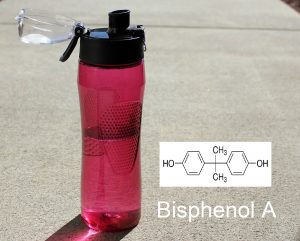Food and Tap Water as Sources of PFAS “Forever Chemicals”

Concerns for exposure to so-called “forever chemicals” are growing. These chemicals are widely used in industry, including for grease-resistant food wrapping, stain-resistant clothing, chemical-resistant and low-friction plastic components, fire-fighting foam and non-stick cookware among numerous other products and industries. While the uses for per- and polyfluoroalkyl substances (PFAS) seem to be ever expanding, so are the risks from exposure to these chemicals.
Health Concerns
Animal studies show potential liver and kidney damage. Human studies show correlations to hormonal disruptions and infertility, decreased immune function, liver problems and cancer (Panieri 2022, Wang 2023). A study in Italy compared populations of individuals with PFAS contaminated drinking water to those without contamination (Mastrantonio 2018). PFAS contamination significantly increased the risks for diabetes, stroke, heart attack and Alzheimer’s dementia. In fact, death from any cause was increased by almost 20% for individuals with contaminated drinking water.
One of the major reasons why these chemicals continue to raise alarms is their stability and accumulation within the body. PFAS contain carbon-fluorine chemical bonds, a type of chemical bond that is very stable and resistant to degradation in the environment. As such, these chemicals can easily build up over time.
In humans, once ingested or absorbed into the body, PFAS are very difficult to eliminate. Estimates suggest that it takes between four and nine years for the body to eliminate half of any dose that has been absorbed or consumed (Olsen 2007).
Food and Water PFAS Contamination
Due to their ubiquity and heavy use, PFAS are contaminating ground and surface waters, soil and house dust (Kuehn 2019, Brusseau 2020, Hall 2020). They are also readily detectable in human blood and breast milk (LaKind 2022, Bashir 2022). In fact, research suggests that immigrants that come to the United States initially have low blood levels of the chemicals which increase in proportion to the length of their time living here in the United States (Bashir 2022). As such, it’s worth trying to understand what are the sources for PFAS, and if food and water significantly contribute to human exposure.
PFAS Exposure and Tap Water
Contaminated tap water is often a source for PFAS. A study found that levels of PFAS in tap water correlated with levels found in the blood of individuals that drink eight or more glasses of tap water per day (Hu 2019). The results indicate that tap water can be a major source of PFAS exposure, especially in areas with higher levels.
Safe levels of PFAS in drinking water are slowly being established. Unfortunately, PFAS come in many different forms and recommendations do not cover all PFAS. Two of the main PFAS of concern that have advisory limits are PFOA and PFOS. In the United States, the Environmental Protection Agency advises that drinking water levels that are below 0.004 and 0.02 parts per trillion respectively, are likely safe for long-term consumption. These levels are equivalent to just 4 nanograms per liter (4 ng/L) and 20 ng/L. Just trying to measure such low quantities is difficult, highlighting the concern for even tiny amounts of these chemicals present in the water supply. For sake of comparison, a single human cell weighs about one nanogram. A penny weighs 2,500,000,000 nanograms.
Unfortunately, levels in tap water are often above safe levels. A study in New Jersey found that 70% of public water supplies had elevated levels ranging between 5-174 ng/L of PFAS (Post 2013). A spill in West Virginia produced levels that averaged around 3740 ng/L in local drinking water (Emmet 2006). The spill caused significant elevations in blood levels for those who were exposed.
PFAS contamination of drinking water appears to be widespread. A separate study also found PFAS chemicals in the majority of drinking water tested throughout multiple locations in the United States (Appleman 2014). PFAS levels have also been documented in Shanghai China, (averaging 130 ng/L) (Mak 2009), South Korea (averaging 11.9 ng/L) (Park 2018), The Czech Republic (averaging 2.34 ng/L) (Jurikova 2022) Germany and Spain (ranging from 0.04-258 ng/L) (Llorca 2012), and Guatemala City (ranging from 0-64.2 ng/L) (Redmon 2022).
Food Sources
Freshwater Fish

Most food sources of PFAS are from animal foods or animal products. One of the most contaminated foods with PFAS are freshwater, wild-caught fish. A study in New Hampshire collected 62 fish from local lakes and streams. All but two of the fish exceeded the maximum recommended daily intake of PFAS. Even more concerning, 21% of samples exceeded the weekly recommended intake (Pickard 2022).
Unfortunately, New Hampshire isn’t an outlier. Earlier testing by the EPA found concentrations averaged 11,800 ng/kg in freshwater fish from around the United States (Barbo 2023). In other words, a single serving of wild-caught, freshwater fish can be the equivalent of drinking contaminated water (with 48 ng/L) for one month!
Other countries have turned up problems as well. Norwegian freshwater fish located near pollution sources had levels ranging between 90,500 to 299,000 ng/kg (Langberg 2022). A study in Germany found average levels in freshwater fish of 11,300 ng/kg (Rüdel 2022). In Vietnam, levels from local lakes averaged 1000 ng/kg in fish meat, although fish blood averaged much higher, at around 16,000 ng/L (Hoa 2022).
Unfortunately, due to the level of contamination, freshwater fish from around the world should likely not be consumed on a regular basis.
Dairy Products
Dairy products are also a more common source of PFAS. A study in South Africa found that milk and infant formulas contained between 80 and 155.1 ng/L of PFAS (Macheka 2021). A study in Poland found concerning levels in milk as well. The most concentrated PFAS was estimated to average around 13,340 ng/kg. Worryingly, in the study, 43% of the dairy samples contained levels that were beyond what the testing system could effectively quantify (Sznajder-Katarzyńska 2019).
While some studies suggest that dairy contamination with PFAS is lower in the United States, other studies appear to refute this. A study on pregnant women in the U.S. found detectable levels of seven PFAS chemicals in over 65% of participants. Additionally, the strongest correlations in the study were found between milk and cheese consumption with two of the identified PFAS (Eick 2023).
Processed and Fast Food
Another dominant source of PFAS exposure comes from processed food and fast foods. Food wrappers and other food contact materials often contain PFAS chemicals to provide grease resistance and non-stick surfaces. This problem is most acutely present in fast food and processed food wrappers.
A recent review found that migration levels from food contact materials for the average individual likely exceeds the recommended weekly intake of PFAS chemicals. The study found that levels easily breached standard recommendations with an estimated exposure of between six and 35 times above safe limits from food wrappers (Lerch 2023).
Ways to Minimize Exposure
Fortunately, there are some ways in which we can reduce exposure to PFAS. First, since tap water is often a major source, filtration and other treatment methods can make a difference. Carbon filters, reverse osmosis systems, nanofiltration and ion exchange membranes can all reduce PFAS in tap water (Mulhern 2021, Zaggia 2016, Lu 2020). However, buying bottled water is not a solution as it is often contaminated (Chow 2021).
Second, it likely makes sense to severely restrict the consumption of wild-caught, freshwater fish from inland lakes and streams. Reducing dairy consumption, processed food and fast food will also likely help to decrease exposure to the chemicals.
Conclusion
PFAS are a vast and growing problem, especially considering their stability in the environment and the difficulty in eliminating them from the human body. As we better understand the scope of the problem, we can hopefully start to minimize the risks of further environmental damage and human exposure by limiting the use of such potentially dangerous chemicals.



